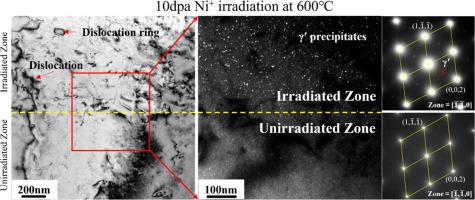离子辐照在高温下诱导IN617的增强沉淀
IF 3.2
2区 工程技术
Q3 MATERIALS SCIENCE, MULTIDISCIPLINARY
引用次数: 0
摘要
镍基高温合金的高温辐照响应仍然是先进核反应堆应用的关键知识缺口。本研究通过电镜表征和纳米压痕相结合的方法,研究了在600℃和800℃高达10 dpa的Ni2+离子辐照下IN617合金的组织演变和力学性能变化。显微组织表征表明,辐照减小了碳化物的尺寸和体积分数,同时促进了γ′相的析出。γ′析出的增强可归因于辐照引起的明显的原子扩散。此外,由于热湮灭作用,800℃辐照样品中的位错密度远低于600℃辐照样品。γ′的析出和位错密度的增加都有助于提高辐照样品的纳米压痕硬度。这些发现建立了辐照温度、沉淀稳定性和IN617合金机械降解之间的基本关系。本文章由计算机程序翻译,如有差异,请以英文原文为准。

Enhanced precipitation in IN617 induced by ion irradiation at elevated temperatures
The high-temperature irradiation response of Ni-based superalloys remains a critical knowledge gap for advanced nuclear reactor applications. In this study, the microstructural evolution and mechanical property changes in IN617 alloy under Ni2+ ion irradiation up to 10 dpa at 600 °C and 800 °C were investigated via combined electron microscopic characterizations and nanoindentation. Microstructural characterizations reveal that irradiation reduces the size and volume fraction of carbides, while promoting γ' phase precipitation. The enhanced γ' precipitation can be attributed to the pronounced atomic diffusion induced by irradiation. Furthermore, the dislocation density in the sample irradiated at 800 °C is much lower than that at 600 °C due to thermal annihilation. Both γ' precipitation and increased dislocation density contribute to the higher nanoindentation hardness in the irradiated samples. These findings establish fundamental relationships between irradiation temperature, precipitate stability, and mechanical degradation in IN617 alloy.
求助全文
通过发布文献求助,成功后即可免费获取论文全文。
去求助
来源期刊

Journal of Nuclear Materials
工程技术-材料科学:综合
CiteScore
5.70
自引率
25.80%
发文量
601
审稿时长
63 days
期刊介绍:
The Journal of Nuclear Materials publishes high quality papers in materials research for nuclear applications, primarily fission reactors, fusion reactors, and similar environments including radiation areas of charged particle accelerators. Both original research and critical review papers covering experimental, theoretical, and computational aspects of either fundamental or applied nature are welcome.
The breadth of the field is such that a wide range of processes and properties in the field of materials science and engineering is of interest to the readership, spanning atom-scale processes, microstructures, thermodynamics, mechanical properties, physical properties, and corrosion, for example.
Topics covered by JNM
Fission reactor materials, including fuels, cladding, core structures, pressure vessels, coolant interactions with materials, moderator and control components, fission product behavior.
Materials aspects of the entire fuel cycle.
Materials aspects of the actinides and their compounds.
Performance of nuclear waste materials; materials aspects of the immobilization of wastes.
Fusion reactor materials, including first walls, blankets, insulators and magnets.
Neutron and charged particle radiation effects in materials, including defects, transmutations, microstructures, phase changes and macroscopic properties.
Interaction of plasmas, ion beams, electron beams and electromagnetic radiation with materials relevant to nuclear systems.
 求助内容:
求助内容: 应助结果提醒方式:
应助结果提醒方式:


